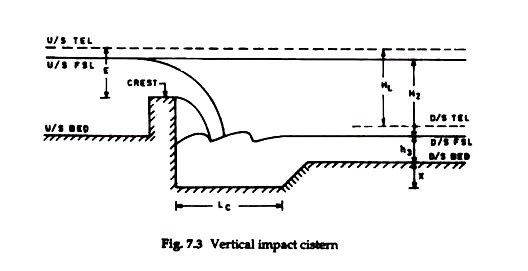This article throws light upon the four main types of cisterns. The types are: 1. Vertical Impact Cisterns 2. Horizontal Impact Cisterns 3. Inclined Impact Cisterns 4. No Impact Cisterns.
Type # 1. Vertical Impact Cisterns:
In these cisterns (Fig. 7.3), there is impact of a stream of water falling freely. The path of such a stream is, obviously, parabolic. This type of cistern is very efficient for the dissipation of surplus energy when the drop is sufficient so that the falling stream becomes almost vertical.
The dimensions of the cistern should be such that it serves the purposes of stilling and combing out the residual eddies and disturbances. The length LC and the depth, x of the cistern can be determined only by empirical expressions given by different investigators.
U.P.I.R.I, has proposed the following relations:
The symbols used in the above relations have been explained in Fig. 7.3 and their values are in metres. In most of the vertical impact cisterns, roughening is not provided. Instead, a short length of cistern is provided for stilling, and such a provision has been found to be satisfactory.
To prevent the falling nappe from adhering to the masonry face of the fall, aeration of nappe is necessary and is provided by aeration pipes embedded in the wing walls just downstream of the crest. The exit from the cistern should be smooth so that the flow is streamlined before it enters the downstream channel.
Type # 2. Horizontal Impact Cisterns:
For this type of cistern (Fig. 7.4), water, after passing over the crest, flows on a glacis whose reverse curve at the downstream end turns the inclined supercritical flow to horizontal supercritical flow before it strikes the subcritical flow of the downstream channel resulting in the formation of a hydraulic jump. It is usual to depress the cistern downstream of the jump location until the depth in the cistern increases by about 25 % of the tail water depth for the formation of hydraulic jump.
Type # 3. Inclined Impact Cisterns:
For such cisterns, the glacis is carried straight down into the cistern, and reliance is placed upon the effectiveness of the jump forming on the glacis for the destruction of surplus energy.
However, the vertical component of the supercritical jet is not affected by the impact and, hence, the energy dissipation is inefficient. Therefore, the cistern has to accommodate the roughening devices and, hence, the cistern length for this class of cisterns is more than that for the preceding classes of cisterns.
Type # 4. No Impact Cisterns:
Hydraulic impact is possible only when a supercritical flow meets a subcritical flow. In low falls and falls with large submergence, hydraulic impact may not be possible. Hence, other means of energy dissipation are adopted. A properly designed baffle wall along-with suitable roughening devices are useful means of energy dissipation for such cases.


